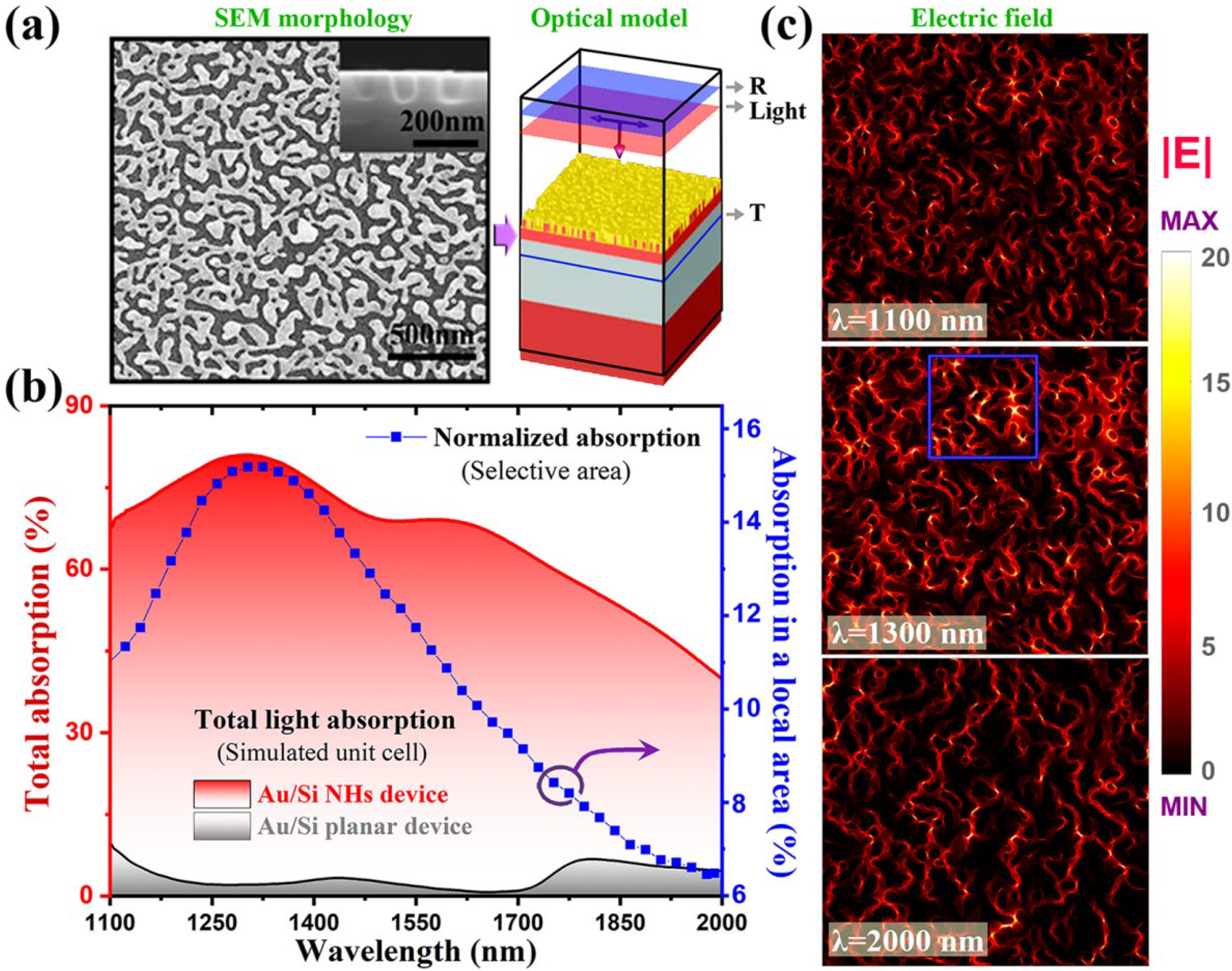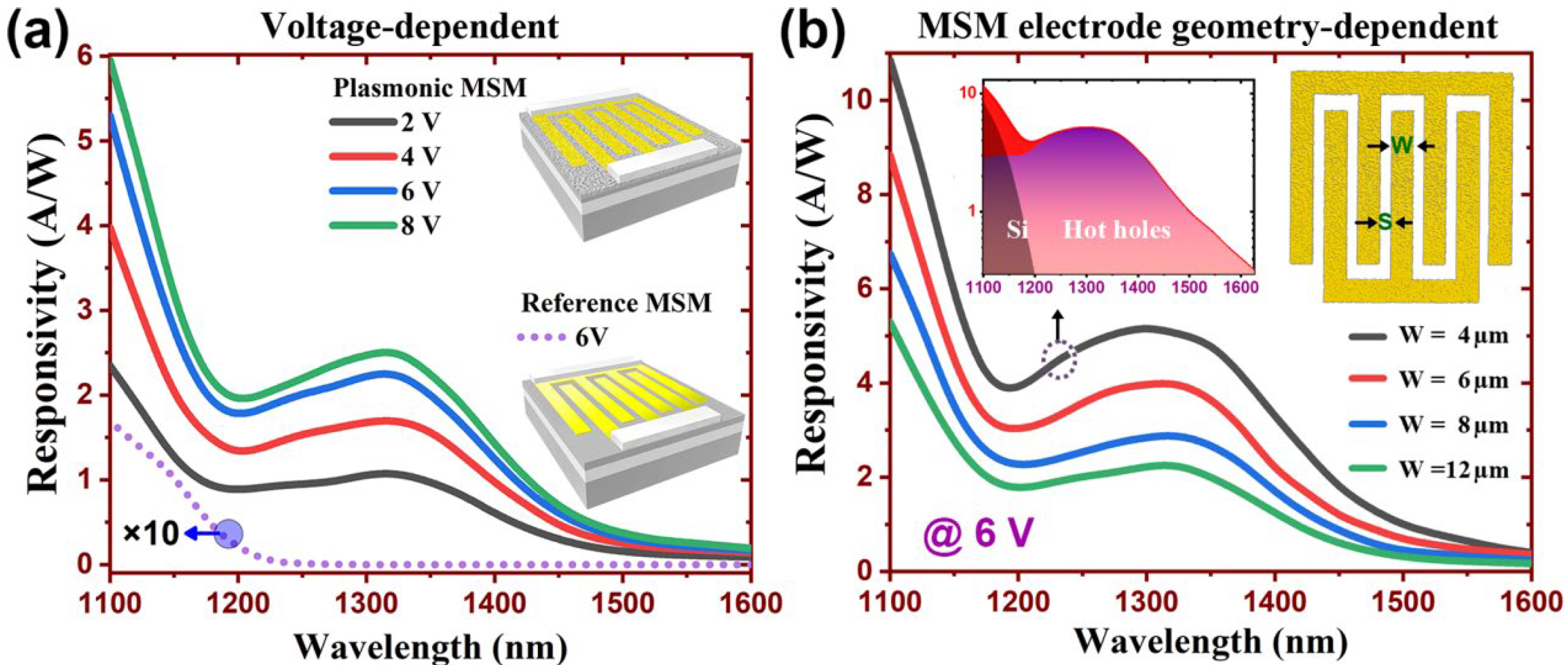Plasmonic Near-Infrared Photoconductor Based on Hot Hole Collection in the Metal-Semiconductor-Metal Junction
Abstract
:1. Introduction
2. Plasmonic Hot Hole Based MSM Photoconductor
3. Fabrication of the Au/SiNHs Structure and the MSM Photoconductor
4. Plasmonic Absorption Properties of the Au/SiNHs Structure
5. Photoelectric Characterization on the Plasmonic MSM Photoconductor
6. Conclusions
Author Contributions
Funding
Institutional Review Board Statement
Informed Consent Statement
Data Availability Statement
Conflicts of Interest
References
- Konstantatos, G.; Sargent, E.H. Nanostructured materials for photon detection. Nat. Nanotech. 2010, 5, 391–400. [Google Scholar] [CrossRef] [PubMed]
- Rogalski, A.; Antoszewski, J.; Faraone, L. Third-generation infrared photodetector arrays. J. Appl. Phys. 2009, 105, 4. [Google Scholar] [CrossRef] [Green Version]
- García de Arquer, F.P.; Armin, A.; Meredith, P. Solution-processed semiconductors for next-generation photodetectors. Nat. Rev. Mater. 2017, 2, 1–17. [Google Scholar] [CrossRef] [Green Version]
- Piccardo, M.; Rubin, N.A.; Meadowcroft, L. Mid-infrared two-photon absorption in an extended-wavelength InGaAs photodetector. Appl. Phys. Lett. 2018, 112, 041106. [Google Scholar] [CrossRef]
- Oehme, M.; Werner, J.; Kasper, E. High bandwidth Ge p-i-n photodetector integrated on Si. Appl. Phys. Lett. 2006, 89, 071117. [Google Scholar] [CrossRef]
- Itsuno, A.M.; Phillips, J.D.; Velicu, S. Mid-wave infrared HgCdTe nBn photodetector. Appl. Phys. Lett. 2012, 100, 161102. [Google Scholar] [CrossRef]
- Liu, J.; Li, X.; Guo, Y.; Qyyum, A.; Shi, Z.; Feng, T.; Zhang, Y.; Jiang, C.; Liu, X. SnSe2 Nanosheets for Subpicosecond Harmonic Mode-Locked Pulse Generation. Small 2019, 15, 1902811. [Google Scholar] [CrossRef]
- Feng, J.; Li, X.; Zhu, G.; Wang, Q. Emerging High-Performance SnS/CdS Nanoflower Heterojunction for Ultrafast Photonics. ACS Appl. Mater. Interfaces 2020, 12, 43098–43105. [Google Scholar] [CrossRef]
- Casalino, M.; Coppola, G.; De La Rue, R.M. State-of-the-art all-silicon sub-bandgap photodetectors at telecom and datacom wavelengths. Laser Photonics Rev. 2016, 10, 895–921. [Google Scholar] [CrossRef] [Green Version]
- Mailoa, J.P.; Akey, A.J.; Simmons, C.B. Room-temperature sub-band gap optoelectronic response of hyperdoped silicon. Nat. Commun. 2014, 5, 1–8. [Google Scholar] [CrossRef]
- Casalino, M.; Coppola, G.; Iodice, M. Silicon photodetectors based on internal photoemission effect: The challenge of detecting near infrared light. In Proceedings of the 2014 16th International Conference on Transparent Optical Networks (ICTON), Graz, Austria, 6–10 July 2014; pp. 1–4. [Google Scholar]
- Knight, M.W.; Sobhani, H.; Nordlander, P. Photodetection with active optical antennas. Science 2011, 332, 702–704. [Google Scholar] [CrossRef]
- Wen, L.; Chen, Y.; Liu, W.; Su, Q.; Grant, J.; Qi, Z.; Wang, Q.; Chen, Q. Enhanced photoelectric and photothermal responses on silicon platform by plasmonic absorber and omni-schottky junction. Laser Photonics Rev. 2017, 11, 1700059. [Google Scholar] [CrossRef] [Green Version]
- Wen, L.; Chen, Y.; Liang, L.; Chen, Q. Hot electron harvesting via photoelectric ejection and photothermal heat relaxation in hotspots-enriched plasmonic/photonic disordered nanocomposites. ACS Photonics 2018, 5, 581–591. [Google Scholar] [CrossRef]
- Sun, Q.; Zhang, C.; Shao, W.; Li, X. Photodetection by hot electrons or hot holes: A comparable study on physics and performances. ACS Omega 2019, 4, 6020–6027. [Google Scholar] [CrossRef] [Green Version]
- Wen, L.; Liang, L.; Yang, X.; Liu, Z.; Li, B.; Chen, C. Multiband and ultrahigh figure-of-merit nanoplasmonic sensing with direct electrical readout in Au-Si nanojunctions. ACS Nano 2019, 13, 6963–6972. [Google Scholar] [CrossRef]
- Zhai, Y.; Li, Y.; Ji, J.; Wu, Z.; Wang, Q. Hot electron generation in silicon micropyramids covered with nanometer-thick gold films for near-infrared photodetectors. ACS Appl. Nano Mater. 2020, 3, 149–155. [Google Scholar] [CrossRef] [Green Version]
- Petritz, R.L. Theory of photoconductivity in semiconductors films. Phys. Rev. 1956, 104, 1508. [Google Scholar] [CrossRef]
- Cushman, R.J. Film-type infrared photoconductors. Proc. IRE 1959, 47, 1471–1475. [Google Scholar] [CrossRef]
- Dalven, R. A review of semiconductors properties of PbTe, PbSe, PbS and PbO. Infrared Phys. 1969, 9, 141–184. [Google Scholar] [CrossRef]
- Rogalski, A. History of infrared detectors. Opto-Electron. Rev. 2012, 20, 279–308. [Google Scholar] [CrossRef]
- Conley, B.R.; Margetis, J.; Du, W.; Tran, H.; Mosleh, A.; Ghetmiri, S.A.; Tolle, J.; Sun, G.; Soref, R.; Li, B.; et al. Si based GeSn photoconductors with a 1.63 A/W peak responsivity and a 2.4 μm long-wavelength cutoff. Appl. Phys. Lett. 2014, 105, 221117. [Google Scholar] [CrossRef]
- Yu, L.Z.; Wie, C.R. Fabrication of MSM photoconductor on porous Si using micromachined silicon mask. Electron. Lett. 1992, 28, 911. [Google Scholar] [CrossRef]





Publisher’s Note: MDPI stays neutral with regard to jurisdictional claims in published maps and institutional affiliations. |
© 2022 by the authors. Licensee MDPI, Basel, Switzerland. This article is an open access article distributed under the terms and conditions of the Creative Commons Attribution (CC BY) license (https://creativecommons.org/licenses/by/4.0/).
Share and Cite
Sun, Z.; Zhong, Y.; Dong, Y.; Zheng, Q.; Nan, X.; Liu, Z.; Wen, L.; Chen, Q. Plasmonic Near-Infrared Photoconductor Based on Hot Hole Collection in the Metal-Semiconductor-Metal Junction. Molecules 2022, 27, 6922. https://doi.org/10.3390/molecules27206922
Sun Z, Zhong Y, Dong Y, Zheng Q, Nan X, Liu Z, Wen L, Chen Q. Plasmonic Near-Infrared Photoconductor Based on Hot Hole Collection in the Metal-Semiconductor-Metal Junction. Molecules. 2022; 27(20):6922. https://doi.org/10.3390/molecules27206922
Chicago/Turabian StyleSun, Zhiwei, Yongsheng Zhong, Yajin Dong, Qilin Zheng, Xianghong Nan, Zhong Liu, Long Wen, and Qin Chen. 2022. "Plasmonic Near-Infrared Photoconductor Based on Hot Hole Collection in the Metal-Semiconductor-Metal Junction" Molecules 27, no. 20: 6922. https://doi.org/10.3390/molecules27206922




